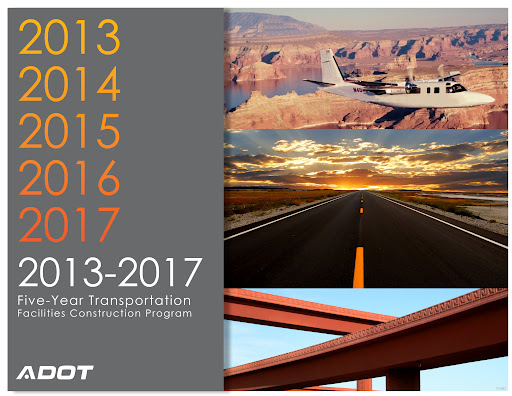State Transportation Board approves ADOT's Five-Year Construction Program
State Transportation Board approves ADOT's Five-Year Construction Program

The approved 2013-2017 Five Year Program
Would you say that you’re a planner, or do you adhere to more of a “let’s see what happens” approach to life?
Nothing wrong with either attitude, but here at ADOT we’re definitely planners (no surprise – we’ve blogged plenty about it.One of the ways we continue to plan ahead is through the development of the Five-Year Transportation Facilities Construction Program.You might remember from this blog post that the five-year program acts as a kind of blue print – it details where, when and how regional, state and federal funding will be spent for future projects.
We blogged about the plan back in March when we were seeking comments from the public (nearly 600 of you responded), but today we wanted to provide an update and let you know that the State Transportation Board formally approved the plan last Friday.
More about the 2013-2017 Five-Year Program
The 2013-2017 Five-Year Program reflects a change in philosophy and expenditures for ADOT. Due to a major decline in transportation funding, the agency must shift priorities to more preservation, maintenance and modernization of our highways and infrastructure.
For 2013 through 2017, the total for the highway portion of the Five-Year Program is set at about $940 million per year to preserve, modernize and improve Arizona’s highways.
That’s down from the $1.1 billion per year from the 2012-2016 Five-Year Program, due primarily to the decline in funding resulting from the weak economy. Of the total amount of funding estimated over the next five years, about half is designated for the Metro Phoenix region, in part because of the Valley’s half-cent sales tax for transportation projects, approved by voters in 2004. Approximately $126 million is designated for aviation projects in the Five-Year Program.
Looking five years into the future can be difficult, especially considering the current status of the economy. That’s why the 2013 and 2014 portions of the program are “fiscally constrained” – meaning based on an expected budget – while the three remaining years are built on budget estimates, which is one reason the Five-Year Program is annually updated.
So, it’s a safe bet that we’ll be blogging about the next Five-Year Program in a year.

